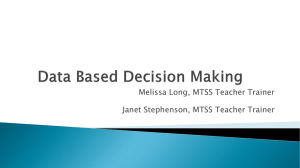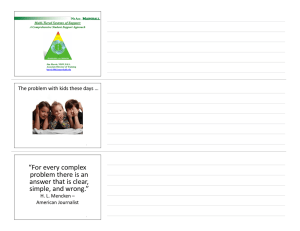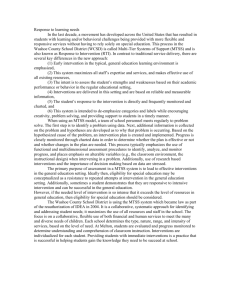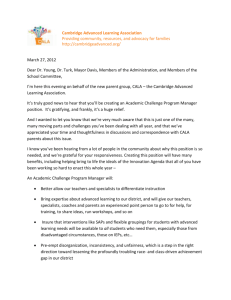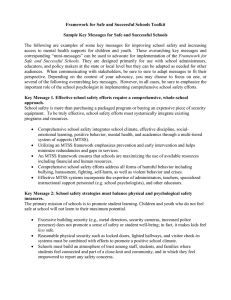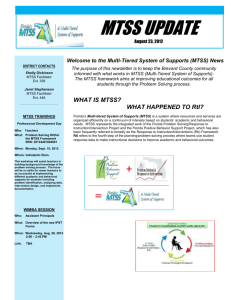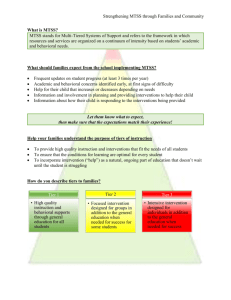IV. PROGRAM APPLICATION DIRECTIONS:
advertisement
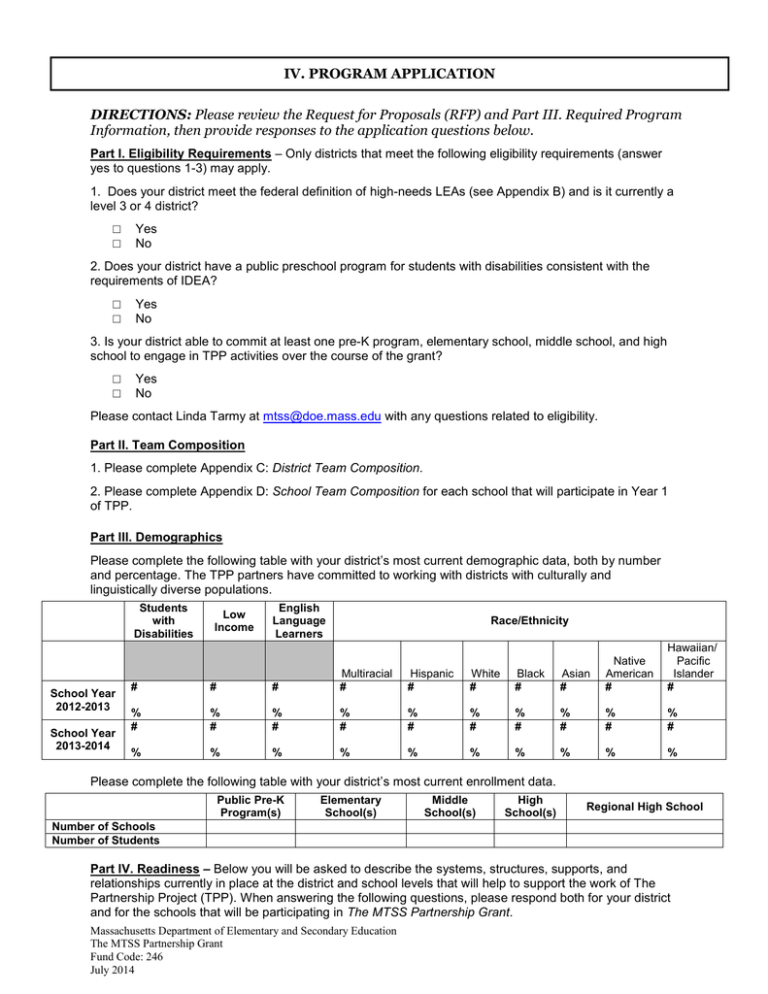
IV. PROGRAM APPLICATION DIRECTIONS: Please review the Request for Proposals (RFP) and Part III. Required Program Information, then provide responses to the application questions below. Part I. Eligibility Requirements – Only districts that meet the following eligibility requirements (answer yes to questions 1-3) may apply. 1. Does your district meet the federal definition of high-needs LEAs (see Appendix B) and is it currently a level 3 or 4 district? □ □ Yes No 2. Does your district have a public preschool program for students with disabilities consistent with the requirements of IDEA? □ □ Yes No 3. Is your district able to commit at least one pre-K program, elementary school, middle school, and high school to engage in TPP activities over the course of the grant? □ □ Yes No Please contact Linda Tarmy at mtss@doe.mass.edu with any questions related to eligibility. Part II. Team Composition 1. Please complete Appendix C: District Team Composition. 2. Please complete Appendix D: School Team Composition for each school that will participate in Year 1 of TPP. Part III. Demographics Please complete the following table with your district’s most current demographic data, both by number and percentage. The TPP partners have committed to working with districts with culturally and linguistically diverse populations. Students with Disabilities School Year 2012-2013 School Year 2013-2014 Low Income English Language Learners Race/Ethnicity Hawaiian/ Pacific Islander # # # # Multiracial # Hispanic # White # Black # Asian # Native American # % # % # % # % # % # % # % # % # % # % # % % % % % % % % % % Please complete the following table with your district’s most current enrollment data. Public Pre-K Program(s) Elementary School(s) Middle School(s) High School(s) Regional High School Number of Schools Number of Students Part IV. Readiness – Below you will be asked to describe the systems, structures, supports, and relationships currently in place at the district and school levels that will help to support the work of The Partnership Project (TPP). When answering the following questions, please respond both for your district and for the schools that will be participating in The MTSS Partnership Grant. Massachusetts Department of Elementary and Secondary Education The MTSS Partnership Grant Fund Code: 246 July 2014 Family Engagement 1. Please describe the systems, structures, and supports that are in place in your district/school(s) related to enhancing community/family engagement (for example, family access to health, social, recreational, and supplemental educational services; a dedicated staff person identified; professional development for parents; outreach activities; etc.). a. District response b. School response(s) Community Partners 2. What, if any, existing relationships do your district/school(s)/pre-K programs have with community partners (for example, mental health services, out-of-school time programs, family supports, etc.)? a. District response b. School response(s) Pre-K to 12 3. Please give your district’s rationale for selecting the pre-K program and the three or more schools that will be part of The MTSS Partnership Grant. For each program/school please include: a. Need b. Readiness (for example, district or school level structures in place for implementing evidence-based practices, attendance at statewide conferences, participation in statewide initiatives such as UDL or PBIS, recipient of MTSS planning grant, etc.) 4. Do you have students in your public pre-school(s) that also attend a private pre-school, head start, or out-of-school-time program? If yes, please describe the collaboration between the public pre-school(s) and other community early childhood settings. 5. What professional development (PD) structures and supports are in place in your district, and in the schools identified to participate in The MTSS Partnership Grant, for practitioners in the mixed delivery system serving students through Early Intervention, public pre-school, child care, Head Start, or Out-of-School-Time programs (for example, frequency of PD, methods for assessing needs, etc.)? a. District response b. School/program response(s) 6. What professional development (PD) structures and supports are in place in your district, and in the schools identified to participate in The MTSS Partnership Grant, for K-12 educators (for example, frequency of PD, designated PD coordinator, methods for assessing needs, etc.)? a. District response b. School response(s) 7. What structures are in place in your district to review local data to inform decisions at both the school and district levels (for example, existence of a data team, formalized systems for collecting and analyzing academic and non-academic data, etc.)? a. District response b. School response(s) 8. Please complete the table below with your district’s placement data for students with disabilities. Least Restrictive Environment Data for Students with Disabilities, ages 6-21 Massachusetts Department of Elementary and Secondary Education The MTSS Partnership Grant Fund Code: 246 July 2014 Percentage of enrolled students with IEPs School Year 2011 - 2012 School Year 2012 – 2013 School Year 2013 - 2014 Full Inclusion (in the general education classroom 80% or more of the day) Partial Inclusion (in the general education classroom 40%79%) Substantially Separate (in the general education classroom less than 40% of the day) Separate Schools, Residential Facilities, or Homebound/ Hospital Placements 9. What initiatives and/or activities are in place to move your district towards creating and/or maintaining inclusive environments? 10. Describe the district/school(s) leadership structures and supports that are in place that will help district/school personnel design and implement a tiered system of support (MTSS)? a. District response b. School response(s) 11. Which initiatives within a tiered system of support (MTSS) is your district currently engaged in? Please describe. a. Academic Tiered System of Supports b. Positive behavioral interventions and supports (PBIS) c. Supporting students’ social, emotional, and health needs – internal or external d. Universal Design for Learning (UDL) e. Other (for example, Responsive Classroom, Trauma Sensitive Schools, etc.) Secondary Transition 12. Please describe your current secondary transition practices, including how you collaborate with state agencies such as MRC, DDS, and DMH, as well as community rehabilitation organizations and other partners. a. District response b. School response(s) 13. What district/school personnel are identified to coordinate and/or provide secondary transition services? 14. How will participation in The MTSS Partnership Grant enhance your current secondary transition practices? a. District response b. School response(s) Higher Education 15. What existing relationships does your district/school(s) have with one or more institutions of higher education? Please name the institution(s) of higher education and describe any activities your district/school(s) engages in with the institution(s) (for example, content area coaching, prepracticum or practicum agreements, paths to licensure, instructional practice courses, program consultation and/or technical assistance etc.). a. District response b. School response(s) Massachusetts Department of Elementary and Secondary Education The MTSS Partnership Grant Fund Code: 246 July 2014
